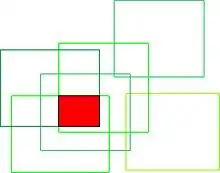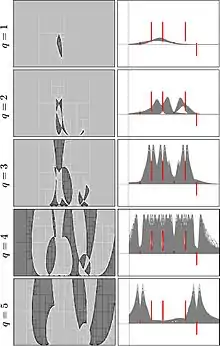The relaxed intersection of m sets corresponds to the classical intersection between sets except that it is allowed to relax few sets in order to avoid an empty intersection. This notion can be used to solve constraints satisfaction problems that are inconsistent by relaxing a small number of constraints. When a bounded-error approach is considered for parameter estimation, the relaxed intersection makes it possible to be robust with respect to some outliers.
Definition
The q-relaxed intersection of the m subsets of , denoted by is the set of all which belong to all 's, except at most. This definition is illustrated by Figure 1.

Define
We have
Characterizing the q-relaxed intersection is a thus a set inversion problem. [1]
Example
Consider 8 intervals:
We have
Relaxed intersection of intervals
The relaxed intersection of intervals is not necessary an interval. We thus take the interval hull of the result. If 's are intervals, the relaxed intersection can be computed with a complexity of m.log(m) by using the Marzullo's algorithm. It suffices to sort all lower and upper bounds of the m intervals to represent the function . Then, we easily get the set
which corresponds to a union of intervals. We then return the smallest interval which contains this union.
Figure 2 shows the function associated to the previous example.

Relaxed intersection of boxes
To compute the q-relaxed intersection of m boxes of , we project all m boxes with respect to the n axes. For each of the n groups of m intervals, we compute the q-relaxed intersection. We return Cartesian product of the n resulting intervals. [2] Figure 3 provides an illustration of the 4-relaxed intersection of 6 boxes. Each point of the red box belongs to 4 of the 6 boxes.

Relaxed union
The q-relaxed union of is defined by
Note that when q=0, the relaxed union/intersection corresponds to the classical union/intersection. More precisely, we have
and
De Morgan's law
If denotes the complementary set of , we have
As a consequence
Relaxation of contractors
Let be m contractors for the sets , then
is a contractor for and
is a contractor for , where
are contractors for
Combined with a branch-and-bound algorithm such as SIVIA (Set Inversion Via Interval Analysis), the q-relaxed intersection of m subsets of can be computed.
Application to bounded-error estimation
The q-relaxed intersection can be used for robust localization [3] [4] or for tracking. [5]
Robust observers can also be implemented using the relaxed intersections to be robust with respect to outliers. [6]
We propose here a simple example [7] to illustrate the method. Consider a model the ith model output of which is given by
where . Assume that we have
where and are given by the following list
The sets for different are depicted on Figure 4.

References
- ↑ Jaulin, L.; Walter, E.; Didrit, O. (1996). Guaranteed robust nonlinear parameter bounding (PDF). In Proceedings of CESA'96 IMACS Multiconference (Symposium on Modelling, Analysis and Simulation).
- ↑ Jaulin, L.; Walter, E. (2002). "Guaranteed robust nonlinear minimax estimation" (PDF). IEEE Transactions on Automatic Control. 47 (11): 1857–1864. doi:10.1109/TAC.2002.804479.
- ↑ Kieffer, M.; Walter, E. (2013). Guaranteed characterization of exact non-asymptotic confidence regions in nonlinear parameter estimation (PDF). In Proceedings of IFAC Symposium on Nonlinear Control Systems, Toulouse : France (2013).
- ↑ Drevelle, V.; Bonnifait, Ph. (2011). "A set-membership approach for high integrity height-aided satellite positioning". GPS Solutions. 15 (4): 357–368. doi:10.1007/s10291-010-0195-3. S2CID 121728552.
- ↑ Langerwisch, M.; Wagner, B. (2012). "Guaranteed Mobile Robot Tracking Using Robust Interval Constraint Propagation". Intelligent Robotics and Applications..
- ↑ Jaulin, L. (2009). "Robust set membership state estimation; Application to Underwater Robotics" (PDF). Automatica. 45: 202–206. doi:10.1016/j.automatica.2008.06.013.
- ↑ Jaulin, L.; Kieffer, M.; Walter, E.; Meizel, D. (2002). "Guaranteed robust nonlinear estimation with application to robot localization" (PDF). IEEE Transactions on Systems, Man and Cybernetics, Part C (Applications and Reviews). 32 (4): 374–381. doi:10.1109/TSMCC.2002.806747. S2CID 17436801. Archived from the original (PDF) on 2011-04-28.